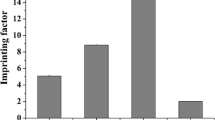Abstract
In this work, the use of molecularly imprinted polymers (MIPs) for citalolpram as anti-depressant drug was studied. Imprinted polymers were prepared from methacrylic acid (MAA; functional monomer), ethylene glycol dimethacrylate (EGDMA; cross-linker), and citalopram (as a drug template) using bulk polymerization method. The polymeric devices were further characterized by FT-IR, thermogravimetric analysis, scanning electron microscopy, and binding experiments. The dissolution media employed in controlled release studies were hydrochloric acid at the pH level of 4.3 and phosphate buffers, at pH levels of 7.2 and 10.1, maintained at 37.0 and 25.0 ± 0.5°C. Results showed the ability of MIP polymers to control the release of citalopram. In all cases, the imprinted polymers showed a higher affinity for citalopram and a slower release rate than the nonimprinted polymers. At the pH level of 4.3 and at the temperature of 25°C, slower release of citalopram imprinted polymer occurred.







Similar content being viewed by others
References
Mosbach K. Molecular imprinting. Trends Biochem Sci. 1994;19:9–14.
Komiyama M, Takeuch T, Mukawa T, Asanuma H. Molecular imprinting. Weinheim: Wiley-VCH; 2003.
Bartsch RA, Maeda M. Molecular and ionic recognition with imprinted polymers. ACS symposium series 703. Washington, DC: American Chemical Society; 2003.
Sellergen B. Molecular imprinted polymers. Amsterdam: Elsevier; 2001.
Takeuchi T, Haginaka J. Separation and sensing based on molecular recognition using molecularly imprinted polymers. J Chromatogr B. 1999;728:1–20.
Haupt K, Mosbach K. Molecularly imprinted polymers and their use in biomimetic sensors. Chem Rev. 2000;100:2495–504.
Ho KC, Yeh WM, Tung TS, Liao JY. Amperometric detection of morphine based on poly(3,4-ethylenedioxythiophene) immobilized molecularly imprinted polymer particles prepared by precipitation polymerization. Anal Chim Acta. 2005;542:90–6.
Javanbakht M, Eynollahi Fard S, Mohammadi A, Abdouss M, Ganjali MR, Norouzi P, Safaraliee L. Molecularly imprinted polymer based potentiometric sensor for the determination of hydroxyzine in tablets and biological fluids. Anal Chim Acta. 2008;612:65–74.
Vallano PT, Remcho VT. Highly selective separations by capillary electrochromatography: molecular imprint polymer sorbents. J Chromatogr A. 2000;887:125–35.
Kamal A, Kumar BA, Arifuddin M, Dastidar SG. Synthesis of 4β-amido and 4β-sulphonamido analogues of podophyllotoxin as potential antitumour agents. Bioorg Med Chem. 2003;11:5135.
Puoci F, Curcio M, Cirillo G, Lemma F, Spizzirri UG, Picci N. Molecularly imprinted solid-phase extraction for cholesterol determination in cheese products. Food Chem. 2008;106:836–42.
Chen W, Han DK, Ahn KD, Kim JM. Molecularly imprinted polymers having amidine and imidazole functional groups as an enzyme-mimetic catalyst for ester hydrolysis. Macromol Res. 2002;10:122–6.
Suedee R, Srichana T, Martin G. Evaluation of matrices containing molecularly imprinted polymers in the enantioselective-controlled delivery of β-blockers. J Control Release. 2000;66:135–47.
Sambe H, Hoshina K, Moadel R, Wainer W, Haginaka J. Uniformly-sized, molecularly imprinted polymers for nicotine by precipitation polymerization. J Chromatogr A. 2006;1134:88–94.
Allender CJ, Richardson C, Woodhouse B, Heard CM, Brain KR. Pharmaceutical applications for molecularly imprinted polymers. Int J Pharm. 2000;195:39–43.
Alvarez-Lorenzo C, Concheiro A. Molecularly imprinted materials as advanced excipients for drug delivery systems. Biotechnol Annu Rev. 2006;12:225–68.
Hiratani H, Alvarez-Lorenzo C. Timolol uptake, release by imprinted soft contact lenses made of N,N-diethylacrylamide, methacrylic acid. J Control Release. 2002;83:223–30.
Alvarez-Lorenzo C, Concheiro A. Molecularly imprinted polymers for drug delivery. J Chromatogr B. 2004;804:231–45.
Alvarez-Lorenzo C, Yanez F, Barreiro-Iglesias R, Concheiro A. Imprinted soft contact lenses as norfloxacin delivery systems. J Control Release. 2006;113:236–44.
Sellergren B, Allender CJ. Molecularly imprinted polymers: a bridge to advanced drug delivery. Adv Drug Deliv Rev. 2005;57:1733–41.
Azodi-Deilami S, Abdouss M, Seyedi SR. Synthesis and characterization of molecularly imprinted polymer for controlled release of tramadol. Cent Eur J Chem. 2010;8:687–95.
Azodi-Deilami S, Abdouss M, Hasani AR. Preparation and utilization of a molecularly imprinted polymer for solid phase extraction of tramadol. Cent Eur J Chem. 2010;8:861–9.
Turchan M, Jara-Ulloa P, Bollo S, Nunez-Vergara LJ, Squella JA, Alvarez-Lueje A. Voltammetric behaviour of bromhexine and its determination in pharmaceuticals. Talanta. 2007;73:913–9.
Suedee R, Srichana T, Rattananont T. Enantioselective release of controlled delivery granules based on molecularly imprinted polymers. Drug Deliv. 2002;9:19–30.
Moffat AC. Clarkes analysis of drugs and poisons in pharmaceuticals, vol. 2. 3rd ed. London: Pharmaceutical Press; 2004.
Guyot A, Sherrington DC, Hodge P. Synthesis and separations using functional polymers. New York: Wiley; 1989. p. 1–36.
Lloyd L. Rigid macroporous copolymers as stationary phases in high-performance liquid chromatography. J Chromatogr A. 1991;544:201–17.
Spivak DA. Optimization, evaluation, and characterization of molecularly imprinted polymers. J Adv Drug Deliv Rev. 2005;57:1779–94.
Rachkov A, Minoura N. Recognition of oxytocin and oxytocin-related peptides in aqueous media using a molecularly imprinted polymer synthesized by the epitope approach. J Chromatogr A. 2000;889:111–8.
Martin P, Jones GR, Stringer F, Wilson ID. Comparison of normal and reversed-phase solid phase extraction methods for extraction of b-blockers from plasma using molecularly imprinted polymers. J Anal. 2003;128:345–50.
Shea KJ, Spivak DA, Sellergren B. Imprinted polymer membranes for the selective transport of targeted neutral molecules. J Am Chem Soc. 1993;115:3368–9.
Mullet WM, Walles M, Levsen K, Borlak J, Pawliszyn J. Multidimensional on-line sample preparation of verapamil and its metabolites by a molecularly imprinted polymer coupled to liquid chromatography–mass spectrometry. J Chromatogr B. 2004;801:297–306.
Acknowledgment
The authors would like to thank Mr. Roghanizad for his technical assistance in experiments.
Author information
Authors and Affiliations
Corresponding author
Rights and permissions
About this article
Cite this article
Abdouss, M., Asadi, E., Azodi-Deilami, S. et al. Development and characterization of molecularly imprinted polymers for controlled release of citalopram. J Mater Sci: Mater Med 22, 2273 (2011). https://doi.org/10.1007/s10856-011-4395-3
Received:
Accepted:
Published:
DOI: https://doi.org/10.1007/s10856-011-4395-3




